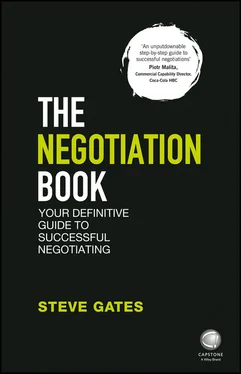UNDERSTANDING THE OPPORTUNITY FROM THEIR PERSPECTIVE
A German electronics firm, ETD, who specialized in Bluetooth technology had built a successful relationship with a number of suppliers to the German auto industry. They had developed software that enabled them to program their “in-car module” to operate with virtually anything Bluetooth-enabled without interference from any other signals. It was a real breakthrough in being able to offer a reliable high-quality solution for those fitting electronics into vehicles. It meant that as well as radio, mobile, and other devices, wiring in vehicles could almost become a thing of the past. The lights on the car, fuel flap, windows, and even ignition could be actioned via this Bluetooth device. Although the electronic hardware was not unique, the software itself was and ETD had set about educating the trade and selling the benefits.
ETD Sales Director Thomas Schnider held a meeting with the procurement team at Brionary, a main components supplier to the auto industry. He presented a carefully planned business case, which justified the premium price point by demonstrating how savings could be made elsewhere as a result of using their software.
ETD understood that this type of change would at best be considered for the next generation of vehicles. Their excitement for this potential prevented them from getting inside the head of the buyers at Brionary. The questions asked by Brionary were:
1. “Can we buy access to the software and program ourselves?”
2. “We purchase most of the electronics through suppliers who we are co-invested in. How can we overcome this challenge?”
3. “How long do you think it will be before this type of software is copied?”
The answer: probably before the next generation of vehicles comes to market.
Thomas and his team retreated to their office in Cologne to reassess their strategy. They had approached the opportunity and the potential to negotiate terms from inside their own head. A month later they offered Brionary access to the software as a concession for a longer-term contract on their existing range of hardware components. Had they been in the heads of Brionary, who clearly had an open mind to long-term co-investment, their approach and the outcome may have been quite different.
Challenge 2: There are no rules
In negotiation there are no rules. No set procedures, no cans or cannots. Negotiation is often likened to a game of chess – the difference being that in most negotiations you are not necessarily trying to beat an opponent, and are not restricted to alternate moves. Although there may be no absolute rules in negotiation, there are parameters within which we can operate. Most negotiators are empowered by their boss to negotiate but only to a certain level, beyond which discussions are usually escalated. Total empowerment results in exposure and risk which for obvious reasons is usually inappropriate.
Challenge 3: Knowing when you have performed well
How will you know how well you have negotiated? You won’t, because the other party is unlikely to tell you how you might have done better or how well you performed relative to their other options.
So, without the benefit of feedback from those we negotiate with, we have to rely on previous precedents (the outcome last time round), or absolute measurements (our profit and loss sheet), and have the humility to face such questions as:
• What might I have done differently?
• Might I have timed things differently?
• Might I have included other issues?
• Might I have tabled proposals that were better thought through?
• Might I have not agreed so easily at the end?
Questions like these challenge how honest you are being with yourself. A good deal has to be defined, taking all of the circumstances into account. Our ego can lead us to blame our circumstances when the deal becomes challenged. By the time a deal is done, you may just want to get on with implementation rather than reflect on your performance.
Measuring the quality of your agreement, without acknowledging some of the risks or concessions that have allowed for the priceto appear like a “good deal,” is not measuring the total value, thus failing to provide a true reflection of your performance. It is your honesty in self-review that needs to be encouraged if you are to truly measure the real value of your deals and learn from our performances.
the price
A single issue which offers only one measure and is usually not representative of the quality or total value of the agreement.
No good, bad, right, or wrong
In negotiation there is no good or bad, right or wrong. The economies we work in are dynamic, as are our suppliers, customers, and competitors. What was a great deal last week may be less well celebrated this week, because our circumstances are continually changing. Negotiation is about doing things that are appropriate to each situation you face with the information as you see it at that moment in time.
Appropriateness
Knowing how a car was built and how it works does not make you a good driver. When driving with so many obstacles on the road, the challenge is to be able to maintain confidence, navigate, interpret, and, where necessary, respond to situations in the most appropriate way when there is no absolute answer that suits all situations.
The same applies to negotiation in business.
• Should you set out to compete or to work with the other party?
• Should you seek to manipulate the situation or collaborate instead?
• Should you trust them or work on being trusted by them?
• How will your options influence the balance of power?
• Is the perception of power and dependency between you and the other party based on reality?
In so many cases the answer is based on appropriateness ; that is, the ability to adapt and respond, depending on your circumstances. This requires an objective, rational, balanced mindset: a state that few human beings can maintain at all times, especially when faced with degrees of perceived conflict, rejection, and demands, all of which need to be accommodated within the negotiation.
Challenge 4: Nothing happens by accident
The essence of negotiation is doing what is appropriate for your circumstances. This means being conscious of everything that happens before, during, and after your negotiation. In negotiation, nothing happens by accident; everything happens for a reason. Being in control of yourself, your emotions, and the relationship is a critical attribute for a negotiator. The challenge is that these qualities do not, for most of us, come naturally. Effective negotiators develop their awareness to the point that they do not lose touch with the human sensitivities necessary to manage relationships, and that they do not compromise for the sake of personal gratification for their own comfort, or to remove the stress they experience when challenged with the prospect of deadlock.
Конец ознакомительного фрагмента.
Текст предоставлен ООО «ЛитРес».
Прочитайте эту книгу целиком, купив полную легальную версию на ЛитРес.
Безопасно оплатить книгу можно банковской картой Visa, MasterCard, Maestro, со счета мобильного телефона, с платежного терминала, в салоне МТС или Связной, через PayPal, WebMoney, Яндекс.Деньги, QIWI Кошелек, бонусными картами или другим удобным Вам способом.












